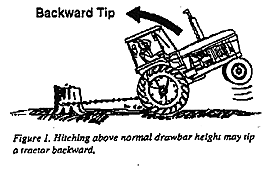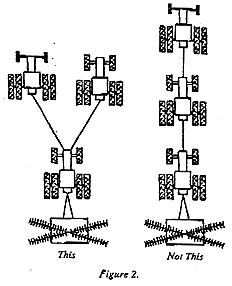
Stuck! The tractor won't go forward or backward, and you need
help! Or, that stump or rock has got to be moved. while backing
the tractor into position for pulling, do you ever wonder,
"Is that weld repair on the hook good? What about the chain
repair we made with a bolt? what's gonna break first, the
chain or the hook?"
Think about these questions when selecting a tow rope, chain, or cable for pulling something. A lot of power will be attached to whatever towing device you choose, easily stretching it to the limit. the hook, chain or cable will become a missile that could cause a terrible injury or death as it rebounds.
A new, 1-inch nylon rope in excellent condition has a breaking strength of up to 25,000 pounds. New steel cable of 1 inch diameter in excellent condition may break at 10,000 pounds, and chain with links make of half-inch diameter material may break at 2,400 pounds. The type and size of hook that is frequently used may break at 4,000 pounds. Whatever combination of these materials you select for a towing device, the weakest part always breaks first. When it breaks, the rest becomes a deadly projectile. Parts such as ball hitches, clevises, chains and even complete bumpers have broken loose, becoming dangerous missiles.
Nylon rope tends to recoil straight back to the point of attachment. The broken hook is like a bullet. Steel cable whips about furiously as it recoils, and chain rebounds unpredictable, eventually winding around anything in its way. All towing materials are dangerous when recoiling from a stretched condition and most can go through tractor cabs and pickup window. The result is often a serious, disabling injury or death.

|
Matching the right size of towing device to the vehicle
doing the pulling is extremely difficult because of various
surfaces, soil conditions and types. Always use the strongest
and best tow rope, cable or chain available. Use the strongest
hooks that you have. Fasten them securely and be sure
that the bumper or drawbar is secure.
Always hitch to the drawbar of the tractor doing the pulling (Figure 1). Hitching to anything other than the drawbar dramatically increases the chance of tipping the tractor.
|

|
When using more than one vehicle for pulling, do not hitch
them single file, with the total effort exerted on only
one chain, cable or rope. Instead, hitch each vehicle
independently, otherwise too much power can easily be
applied to the final towing device (Figure 2). Carefully
coordinate the efforts when more than one towing unit
is used.
How can you make towing safer? First, clear the area of people, both helpers and watchers. Second, always hitch to the drawbar. Third, make sure everything - bumper, drawbar, hooks, chain, cable or nylon rope - is strong enough to handle the load. Fourth, make sure that all attachments are secure. Finally, apply the power smoothly without jerking - do not attempt to use the elasticity of nylon rope to increase your pulling power.
|
| Helping
You Put Knowledge to Work NDSU Extension Service, North Dakota State University of Agriculture and Applied Science, and U.S. Department of Agriculture cooperating. William H. Pietsch, Director, Fargo, North Dakota. Distributed in furtherance of the Acts of Congress of May 8 and June 30, 1914. We offer our programs and facilities to all persons regardless of race, color, national origin, religion, sex, handicap, age, Vietnam era veterans status, or sexual orientation; and are an equal opportunity employee . |
Disclaimer and Reproduction Information: Information in NASD does not represent NIOSH policy. Information included in NASD appears by permission of the author and/or copyright holder. More